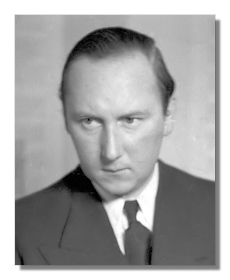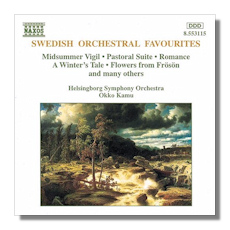
The Internet's Premier Classical Music Source
Related Links
-
Find CDs & Downloads
Amazon - UK - Germany - Canada - France - Japan
ArkivMusic - CD Universe
Find DVDs & Blu-ray
Amazon - UK - Germany - Canada - France - Japan
ArkivMusic-Video Universe
Find Scores & Sheet Music
Sheet Music Plus -
Recommended Links
Site News
Lars-Erik Larsson

(1908 - 1986)
One of the finest composers of Modern Sweden and one of the most successful, Lars-Erik Vilner Larsson (May 15, 1908 - December 26, 1986) practiced a variety of styles in many different genres. His music is noted for its wit and its Nordic lyricism. He began as a Sibelian, completing his First Symphony in 1928. The following year, he received a state grant to study in Vienna with, among others, Alban Berg. Scholars credit Larsson as the Swedish composer to first write a 12-tone piece (movements of the 10 Two-Part Piano Pieces of 1932).
Larsson, however, didn't stay put in any one idiom. The Thirties saw neoclassic works like the Hindemithian Sinfonietta for Strings (1932), the Saxophone Concerto (1934), the Little Serenade for Strings (1934), and the Second Symphony (1936). In 1937, Larsson was appointed to Swedish Radio, where his duties included composing incidental music, conducting mainly light music, and producing programs. His composing centered around his radio work, although he also wrote for the stage and for the movies – both fairly lucrative. Collaborating with the writer Hjalmar Gullberg, he developed a new radio genre – the lyric suite, poems interspersed with short musical movements – and this turned out to be the source of his most popular concert works, the Pastoral Suite (1938) and the magnificent cantata Förklädd gud ("Disguised God," 1940). These scores tended towards neo-romanticism. Indeed, Förklädd gud at times sounds like a streamlined Ring, mixed with Swedish folk music and dance. One also finds more than a suggestion of 19th-century Swedish composer Franz Berwald. The mid-Forties saw a return to independent composition with the String Quartet #1 (1944) and the Symphony #3 (1945). In the late Forties, Larsson turned to a more aggressively modern idiom, seen in the Cello Concerto (1947), the Music for Orchestra (1949), and the Violin Concerto (1952). Larsson returned to 12-tone composition in the Fifties with sections of his Missa brevis (1954), the Adagio for Strings (1960), and the Orchestral Variations (1963). However, he again never devoted himself exclusively to the style. The period also saw the neoclassic 12 Concertinos (1953-57) – designed for professional soloists and amateur string players and with a few of the same ideas popping up among the various concertinos, one of the great contributions to Gebrauchmusik – and the meditative neo-romantic Lyric Fantasy for Orchestra (1966).
Larsson didn't write much, but he often wrote well. His lyricism warms the heart, his dances get the feet moving, and even his more austere works speak directly to a listener. He taps into the folk vein mined by Hugo Alfvén, but without Wagnerian baggage. There's no padding. Incisiveness may well count as his most characteristic trait. His music may not dwell on the highest Olympian peak, but fans of Scandinavian art will find it very easy to love. ~ Steve Schwartz
Recommended Recordings
12 Concertinos
- 12 Concertinos, Op. 45/BIS CD-473
-
Michel Lethiec (clarinet), Christian Lindberg (trombone), Anton Kontra (violin), Sven Verde, Lennart Hedwall, Göran W. Nilson, Okko Kamu, Jan-Olav Wedin, et al./Musica Sveciae, Stockholm Chamber Ensemble, et al.
- 7 Concertinos, Op. 45 #1-7/Intim Musik IMCD030
-
Göran Marcusson (flute), Mårten Larsson (oboe), Urban Claesson (clarinet), Anders Engström (bassoon), Per Göran (French horn), Bengt Danielsson (trumpet), Lars-Göran Carlsson (trombone)/Camerata Roman
- 5 Concertinos, Op. 45 #8-12/Intim Musik IMCD031
-
Jan Stigmer (violin), Per-Ola Lindberg (viola), Bjorg Vaernes (cello), Ingalill Hillerud (double bass), Joakim Kallhed (piano)/Camerata Roman
Förklädd gud (Disguised God)
- Förklädd gud, Op. 24; Symphony #3, Op. 34/BIS CD-96
-
Birgit Nordin (soprano), Anders-Per Jonsson (spoken vocals), Håkan Hagegård (baritone), Sten Frykberg, Helsingborg Symphony Orchestra & Concert Hall Chorus
- Förklädd gud, Op. 24; Pastoral Suite; A Winter's Tale; Little Serenade/Intim Musik IMCD082
-
Jeanette Köhn (soprano), Sven Wollter (spoken vocals), Thomas Lander (baritone), Christopher Warren-Green/Jönköping Sinfonietta, Jönköping Chamber Choir
Pastoral Suite
- Pastoral Suite, Op. 19; God in Disguise; A Winter's Tale; Little Serenade/Intim Musik IMCD082
-
Christopher Warren-Green/Jönköping Sinfonietta
- Pastoral Suite, Op. 19; A Winter's Tale w/ Söderman, Stenhammar, Peterson-Berger, Alfvén & Wirén/Naxos 8.553115
-
Christopher Warren-Green/Jönköping Sinfonietta
















